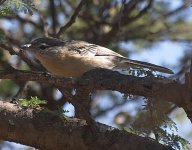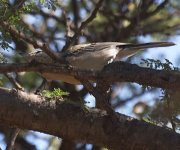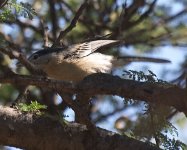-
Welcome to BirdForum, the internet's largest birding community with thousands of members from all over the world. The forums are dedicated to wild birds, birding, binoculars and equipment and all that goes with it.
Please register for an account to take part in the discussions in the forum, post your pictures in the gallery and more.
You are using an out of date browser. It may not display this or other websites correctly.
You should upgrade or use an alternative browser.
You should upgrade or use an alternative browser.
Blackcap (1 Viewer)
- Thread starter leon
- Start date
More options
Who Replied?Desertbirder
Jonathan Meyrav
Harry is unfortunately right... This is not a Blackcap, not a European one at least.
Desertbirder
Jonathan Meyrav
Yes Sylvia atricapilla... was this taken in South Africa, recently ?
Desertbirder said:Yes Sylvia atricapilla... was this taken in South Africa, recently ?
Yes, taken at Tswaing (an meteoric crater about 50KM north of Pretoria), a week ago.
Sorry for not mentioning it in the original post.
Michael Frankis
conehead
Agreed with the others, definitely not Sylvia atricapilla - that is smaller, daintier, uniform grey on the wings (no whitish fringing like this bird has), thinner & smaller bill, shorter tail
Sorry, also like the others, I don't know what it is!
Michael
Sorry, also like the others, I don't know what it is!
Michael
Desertbirder
Jonathan Meyrav
Harry has got a point, that stubby bill and jizz lean towards Bush-Shrikes or maybe Puffbacks ? Not much experince with so far south, My African birding experience ends somewhere in Mozambique...
Desertbirder
Jonathan Meyrav
There are a few East African Puffbacks with no red eyes...
cuckooroller
Registered User
Leon,
There is another bird in RSA that vernacularly goes by Blackcap. Lioptilus nigricapillus. As far as I can tell it isn't this one either. This bird, and I am agreed that it may be some type of Puffback, though not too sold on the Bush-shrike because the beak just doesn't look massive enough, looks to be a juvenile and so who knows what the adult looks like - could be something that we would recognize straight off.
There is another bird in RSA that vernacularly goes by Blackcap. Lioptilus nigricapillus. As far as I can tell it isn't this one either. This bird, and I am agreed that it may be some type of Puffback, though not too sold on the Bush-shrike because the beak just doesn't look massive enough, looks to be a juvenile and so who knows what the adult looks like - could be something that we would recognize straight off.
Rasmus Boegh
BF member
Looks like pre-adult Black-backed Puffback (Dryoscopus cubla). Black cap, dark upperside with pale edging to wing-feathers (esp. shoulder). Underparts dull white with a buff hue.
Rasmus Boegh
BF member
leon said:At first glance I thought it was a puffback, but the red-eyes are missing.
OBS: Note that juv's & imm's Black-backed Puffback show a brown eye (not red as in ad.).

Daft suggestion
Just flicked through the SASOL guide and to me the shape and wing covert pattern are very like a Greater Honeyguide Indicator indicator. I think it could be a juvenile, which would have a darkish crown. In some of the pictures it almost looks to have a buffish wash to the underparts (which would also fit), although that could be a photo effect. Let me know if I'm talking nonsense.
Just flicked through the SASOL guide and to me the shape and wing covert pattern are very like a Greater Honeyguide Indicator indicator. I think it could be a juvenile, which would have a darkish crown. In some of the pictures it almost looks to have a buffish wash to the underparts (which would also fit), although that could be a photo effect. Let me know if I'm talking nonsense.
Rasmus Boegh
BF member
Fifebirder said:Just flicked through the SASOL guide and to me the shape and wing covert pattern are very like a Greater Honeyguide Indicator indicator.
Certainly not Greater Honeyguide, though your thoughts are understandable. The Greater Honeyguide is quite distinctive. Juv's of this species are even more distinctive (perhaps the easiest ID in the whold family), being strikingly bi-coloured. If you have the possibility, check the photo of a juv. Greater Honeyguide on page 287 in HBW vol. 7. In any case, the individual have a bill that is wrong for the Honeyguide, pale edging on wing-feathers too broad, and dark cap too strikingly dark. It should also be mentioned that the greyish-olive cap of Greater Honeyguide always goes below the eye ("the eye is situated in the cap"). I'm 98% certain on it being a pre-ad. Black-backed Puffback...
Last edited:

Hi Rasmus,
I've never seen a Blackbacked Puffback, so can't really comment. I must admit though, if they can look like this then the illustrations and descriptions in the SASOL guide are drastically in need of revision! They simply show a short tailed, strikingly bi-coloured black and white bird that in female and juvenile plumages should apparently show a white supercillium. Not much like this, although to be honest it's more plausible than a Honeyguide!
I've never seen a Blackbacked Puffback, so can't really comment. I must admit though, if they can look like this then the illustrations and descriptions in the SASOL guide are drastically in need of revision! They simply show a short tailed, strikingly bi-coloured black and white bird that in female and juvenile plumages should apparently show a white supercillium. Not much like this, although to be honest it's more plausible than a Honeyguide!
Rasmus Boegh
BF member
Fifebirder said:I've never seen a Blackbacked Puffback, so can't really comment. I must admit though, if they can look like this then the illustrations and descriptions in the SASOL guide are drastically in need of revision! They simply show a short tailed, strikingly bi-coloured black and white bird that in female and juvenile plumages should apparently show a white supercillium.
Hi Fifebirder,
The eye-brow in ad. females certainly isn't as obvious as some guides claim. It is rather vague appearing more like a white front extending just beyond the eye. Even less obvious, as there only is a slightly darker area (often not visible when you actually see the bird in the wild) between this and white on underparts. So, perhaps it would be better described as the white underparts extending around the eye (i.e. the dark cap doesn't go down below the eye. So, the cap doesn't "include the eye", as in various close relative). Ad. females (and males) are indeed strikingly black and white. However, this isn't the case in juv's. Their pattern is similar to the ad. female, but they are rather blackish grey (not deep black) on the upperparts, having buff edging (not white) on the wing. The underparts are dull whitish to buff (not shiny white). The thing that made me say 98% and not 100% was indeed the lenght of the tail. Still, when going through the various guides I have covering the region, I just can't find anything else that even comes close...
Michael Frankis
conehead
Is juv White-crowned Shrike Eurocephalus anguitimens a possibility?
Michael
Michael
Users who are viewing this thread
Total: 2 (members: 0, guests: 2)







